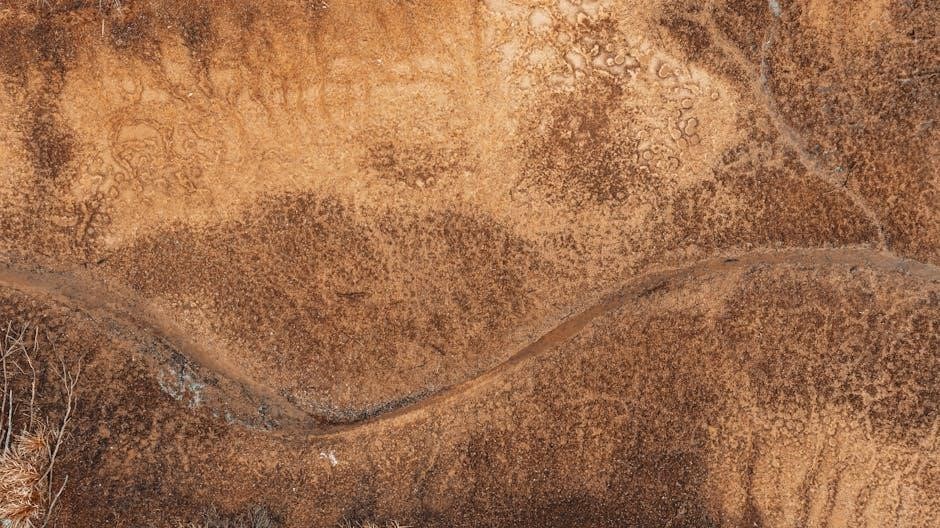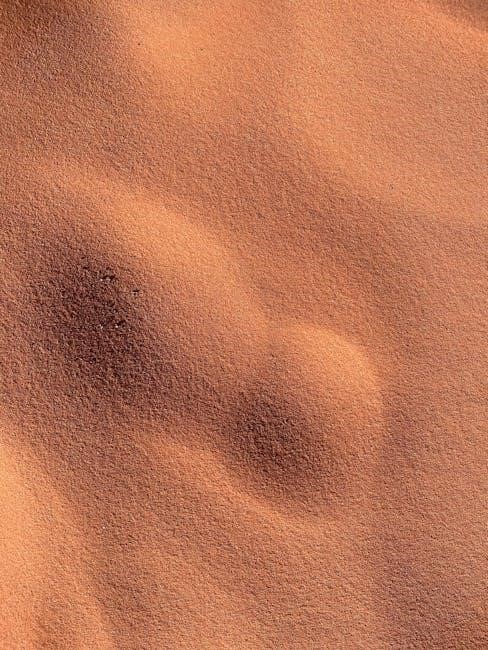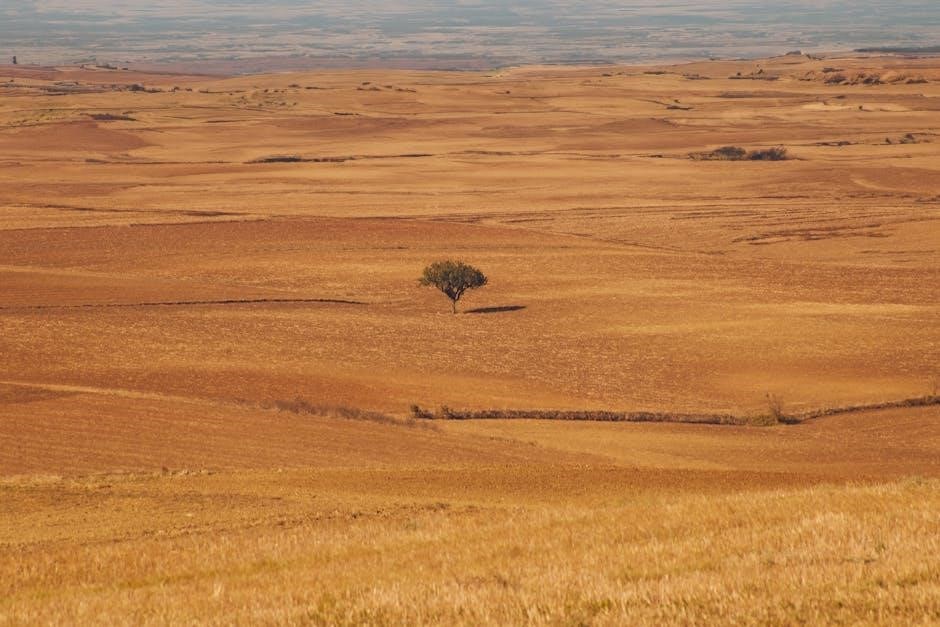The Munsell Soil Color Chart is a standardized tool for identifying and communicating soil colors, widely used in agriculture, environmental science, and research. Available in PDF format, it provides a systematic way to match soil samples with predefined color chips, ensuring consistency and accuracy in soil analysis. The chart is based on the Munsell Color System, which organizes colors by hue, value, and chroma, making it a essential resource for professionals and students alike.
History and Development of the Munsell Color System
Developed by Albert Munsell in the 1900s, the Munsell Color System revolutionized color organization. Initially used for art, it was later adapted for soil classification, becoming a key tool in soil science with standardized color chips and notation.
Early Development of the Munsell Color System
The Munsell Color System was developed by Albert Munsell in the early 1900s, initially as a tool for art education. Munsell, an American painter and educator, aimed to create a logical and intuitive way to organize and teach color theory. His system emphasized three key dimensions: hue (color), value (lightness), and chroma (purity). This approach was groundbreaking, as it introduced a three-dimensional model for color representation, making it easier to understand and communicate color relationships. The system gained popularity and was later expanded into various applications, including soil science, leading to the creation of the Munsell Soil Color Charts. These charts became essential for standardizing soil color classification, particularly in agricultural and environmental studies.
Application of the Munsell System to Soil Color Classification
The Munsell System was adapted for soil color classification to address the need for a standardized method in soil science. By organizing soil colors into a three-dimensional framework of hue, value, and chroma, the system provided a precise way to identify and communicate soil colors. Soil samples are compared with color chips in the chart to determine their Munsell notation, which is then used in soil surveys, environmental studies, and agricultural planning. This method ensures consistency across different regions and researchers, making it a vital tool for understanding soil properties and their implications for land use and environmental health. The Munsell Soil Color Charts are now a global standard, widely used in fieldwork and scientific research.

Structure of the Munsell Soil Color Chart
The Munsell Soil Color Chart consists of multiple pages, each displaying color chips arranged systematically by hue, value, and chroma, aiding precise soil color identification and notation.
Key Components of the Munsell Soil Color Chart
The Munsell Soil Color Chart is built around three primary color attributes: hue, value, and chroma. Hue refers to the basic color (e.g., red, yellow), value indicates lightness (ranging from black to white), and chroma represents color intensity. The chart includes standardized color chips arranged systematically, allowing users to match soil samples accurately. Each chip is labeled with its Munsell notation, providing a universal language for soil color description. The chart also features pages dedicated to specific hues, with gradual transitions in value and chroma, ensuring precise identification. This structured approach makes it an indispensable tool for soil scientists, educators, and researchers worldwide.
Organization of Color Chips in the Chart
The Munsell Soil Color Chart is meticulously organized to facilitate easy and accurate soil color matching. Color chips are arranged in a logical sequence based on the Munsell Color System, with each page dedicated to a specific hue. Within each hue, chips are gradated by value (lightness to darkness) and chroma (color intensity). This systematic layout allows users to quickly narrow down the closest match for a soil sample. The chart includes 322 distinct color chips, ensuring a wide range of soil tones are represented. This organized structure enhances usability, making it a reliable tool for fieldwork and laboratory analysis in soil science and related disciplines.
Explanation of Hue, Value, and Chroma in the Munsell System
In the Munsell Soil Color Chart, colors are defined using three dimensions: hue, value, and chroma. Hue refers to the basic color (e.g., red, yellow, green), value indicates lightness or darkness (ranging from black to white), and chroma represents color intensity or saturation. These components work together to provide a precise color notation, such as “5YR 5/6,” where “5YR” is the hue, “5” is the value, and “6” is the chroma. This system ensures consistency and accuracy in describing soil colors, making it a universal language for soil scientists and researchers. The clear organization of hue, value, and chroma enables users to quickly identify and communicate soil color effectively.
How to Use the Munsell Soil Color Chart
To use the chart, select a soil sample, choose the matching color chip, and note its Munsell notation. Ensure the sample is dry and in natural light for accurate matching.
Step-by-Step Guide to Matching Soil Samples
Begin by drying the soil sample completely to ensure accurate color representation. Next, crumble the soil into fine particles and place it on a white surface or directly against the chart. Hold the Munsell Soil Color Chart at an angle to match the sample under natural light. Compare the soil’s hue, value, and chroma with the color chips, starting with the closest hue group. Once a match is found, record the Munsell notation, which includes hue, value, and chroma. This systematic approach ensures precise and consistent soil color identification, making it invaluable for fieldwork and laboratory analysis.
Practical Applications in Agriculture and Environmental Science
The Munsell Soil Color Chart is a vital tool in agriculture and environmental science, aiding in soil classification and fertility assessment. By matching soil colors, farmers can determine nutrient levels and optimal crop placement. In environmental monitoring, the chart helps identify soil degradation or contamination. It is also used in land use planning and erosion control, providing insights into soil health and structure. Researchers rely on it for consistent data collection across different regions and studies. This practical application ensures that soil color analysis contributes effectively to sustainable land management and scientific research, offering a reliable method for understanding soil properties and their implications for agriculture and the environment.

Digital Versions of the Munsell Soil Color Chart
The Munsell Soil Color Chart is available in PDF format for convenient digital access, enabling easy downloading and sharing for soil analysis and educational purposes worldwide.
Availability of Munsell Soil Color Charts in PDF Format
The Munsell Soil Color Charts are widely available in PDF format, offering convenience for professionals and researchers. These digital versions, such as the 1973 and 1994 editions, can be downloaded from platforms like Scribd or official Munsell websites. The PDF format allows users to access the charts on various devices, ensuring portability and ease of use. Each chart contains standardized color chips arranged by hue, value, and chroma, providing a consistent reference for soil color identification. Digital versions also include detailed notations, enabling precise color matching and documentation. This accessibility makes the Munsell Soil Color Charts a invaluable resource for soil science, agriculture, and environmental studies, fostering accurate and efficient soil color analysis worldwide.
Benefits of Using Digital Munsell Soil Color Charts
Digital versions of the Munsell Soil Color Charts offer numerous advantages, enhancing efficiency and accessibility in soil analysis. PDF formats allow users to access charts on various devices, making them portable and ideal for fieldwork. Digital charts eliminate the risk of physical damage, ensuring durability and long-term usability. They also enable easy sharing and collaboration among researchers and professionals. Advanced search and zoom features in digital versions facilitate quick and precise color matching, reducing the time spent on manual comparisons. Additionally, digital charts can be easily updated, ensuring users always have the latest revisions. These benefits make digital Munsell Soil Color Charts a practical and indispensable tool for modern soil science and environmental studies.
Munsell Soil Color Charts: Tools and Resources
Munsell Soil Color Charts are available as downloadable PDFs, offering practical tools for soil analysis. These resources include software, apps, and revised editions like the 1994 version.
Downloadable Munsell Soil Color Charts and Wheels
The Munsell Soil Color Charts are available in downloadable PDF formats, providing convenient access for soil analysis. These PDFs include detailed color chips and notations, such as the 1994 Revised Edition. Wheels and charts can be freely downloaded from platforms like Scribd, offering tools for education and research. The PDFs are organized by Munsell notation, making it easy to visually match soil samples. Additionally, software like ChromaMagic 2.0 complements these resources, offering advanced color-matching capabilities. These downloadable tools are essential for students, teachers, and professionals in soil science, enabling precise and standardized color classification.
Software and Apps for Munsell Color Matching
Advanced software and apps complement the Munsell Soil Color Chart, enhancing color matching and analysis. Tools like ChromaMagic 2.0 offer digital solutions for precise color identification, allowing users to explore new color modes. These applications enable real-time matching of soil samples with Munsell notations, streamlining fieldwork and research. They also support the conversion of color data into standardized Munsell notation, ensuring consistency. Professionals and researchers benefit from these tools, as they integrate seamlessly with downloadable PDF charts, providing a comprehensive digital workflow. By leveraging technology, these apps enhance the accuracy and efficiency of soil color classification, making them indispensable for modern soil science applications.

The Importance of the Munsell Notation System
The Munsell Notation System provides a universal method for describing soil colors, ensuring consistency and standardization. By using hue, value, and chroma, it allows precise communication of soil color, aiding in classification and research. This system is crucial for maintaining uniformity in soil analysis, enabling accurate comparisons across different studies and regions. Its standardized approach has become the backbone of soil science, facilitating reliable data sharing and advancing environmental understanding. The notation system’s clarity and reproducibility make it an indispensable tool for scientists and professionals worldwide.
Understanding Munsell Notation for Soil Colors
Munsell notation is a standardized method for describing soil colors using three components: hue, value, and chroma. Hue refers to the basic color (e.g., red, yellow, blue), value indicates lightness (from black to white), and chroma represents color intensity. For example, a soil color might be noted as “5YR 5/3,” where 5YR is the hue, 5 is the value, and 3 is the chroma. This system ensures precise and consistent communication of soil colors, making it invaluable for soil classification, research, and environmental studies. By providing a universal language, Munsell notation helps scientists and professionals worldwide compare and analyze soil samples accurately. Its simplicity and reproducibility make it a cornerstone of soil science and related fields.
Role of Munsell Notation in Standardizing Soil Color Classification
Munsell notation plays a pivotal role in standardizing soil color classification by providing a universal and precise system for describing soil hues. This notation ensures consistency across different regions and studies, eliminating subjective interpretations. The use of hue, value, and chroma allows for accurate categorization, which is crucial for soil mapping, fertility assessments, and environmental monitoring. By standardizing soil color description, Munsell notation facilitates global communication among researchers and professionals. It also supports the development of reliable soil databases and comparative analyses. This standardized approach is essential for maintaining accuracy and reproducibility in soil science, making Munsell notation indispensable in modern agricultural and environmental research.
Case Studies and Examples of Munsell Soil Color Chart Usage

The Munsell Soil Color Chart is widely used in real-world applications, such as soil fertility assessments and environmental monitoring. It aids in identifying soil types and conditions, providing precise color matching for accurate analysis. This tool is essential for soil scientists and researchers, offering practical examples of its effectiveness in various field studies and agricultural projects.

Real-World Applications in Soil Science and Research
The Munsell Soil Color Chart is extensively utilized in soil science and research for accurate color identification and analysis. It helps determine soil properties like fertility, organic matter content, and moisture levels, which are crucial for agricultural planning and environmental monitoring. Researchers use the chart to classify soil types, study soil erosion patterns, and assess the impact of land management practices. Additionally, it aids in creating detailed soil maps, which are essential for understanding ecosystem dynamics and supporting sustainable land use policies. The chart’s standardized notation system ensures consistency across studies, making it a vital tool for both fieldwork and laboratory analysis in the scientific community.

Examples of Soil Color Matching Using Munsell Charts
The Munsell Soil Color Chart provides practical examples for matching soil samples with standardized color chips. For instance, a brown soil might be classified as IOYR 5/3, where IOYR represents the hue, 5 is the value, and 3 is the chroma. This notation system ensures precise communication of soil colors. In field studies, researchers often compare soil samples to the chart to document changes in color due to factors like erosion or organic matter decomposition. The chart also includes examples of how different soil horizons, such as topsoil and subsoil, can vary in color, aiding in soil profile analysis. By using the Munsell chart, professionals can consistently and accurately classify soil colors, making it an indispensable tool for soil science and environmental research.

Comparison with Other Soil Color Classification Systems
The Munsell Soil Color Chart stands out for its standardized notation system, offering precise communication of soil colors. Its portability and versatility make it superior for consistent soil color identification across diverse environments.
Unique Features of the Munsell Soil Color Chart
The Munsell Soil Color Chart is distinguished by its precise and standardized color notation system, which includes hue, value, and chroma. This allows for consistent and accurate soil color identification across different environments and studies. The chart’s portability and user-friendly design make it accessible for fieldwork, while its systematic arrangement of color chips ensures ease of use. Additionally, the availability of digital versions, including PDF formats, enhances its accessibility and convenience for modern applications. These features combine to make the Munsell Soil Color Chart a versatile and indispensable tool in soil science and related fields.

Future Trends in Soil Color Analysis
Future trends include digital advancements, AI integration, and smart devices for soil color matching, enhancing accuracy and accessibility for researchers and professionals in environmental and agricultural fields.
Digital Advancements in Soil Color Matching
Digital advancements are revolutionizing soil color matching through innovative tools like mobile apps and software. These technologies integrate the Munsell system with digital imagery, enabling precise color analysis. For instance, ChromaMagic 2.0 offers enhanced color modes, while downloadable PDF charts provide portability. Smart devices equipped with four-channel cameras can capture soil reflectance, converting images into spectral data. This seamless integration of digital solutions with traditional Munsell notation ensures faster, more accurate soil assessments. Professionals can now access digital charts and wheels, facilitating real-time comparisons and data sharing. Such tools not only streamline fieldwork but also enhance the learning experience for students and researchers, making soil color analysis more efficient and accessible than ever before.

The Munsell Soil Color Chart remains an indispensable tool in soil science, offering a standardized method for color identification and communication. Available in PDF format, it combines traditional Munsell notation with modern digital accessibility. By providing a systematic approach to soil color analysis, the chart supports agricultural, environmental, and research applications. Its integration with digital advancements, such as apps and imaging technologies, ensures continued relevance and efficiency. Whether for fieldwork or educational use, the Munsell Soil Color Chart bridges tradition and innovation, fostering accurate and consistent soil assessments worldwide. Its enduring utility underscores its significance in advancing our understanding of soil properties and their role in various ecosystems and scientific studies.
